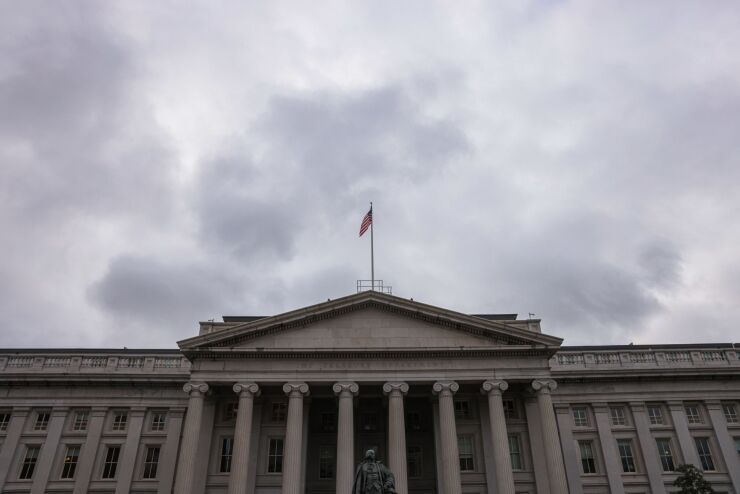(Bloomberg) -- Wall Street is widely expecting the US Treasury to announce a final increase to its sales of long-term debt this week, after a steady ramp up in supply that's sometimes tested buyers' appetites for funding a widening budget deficit.
The Treasury Department is expected on Wednesday to follow through on its November guidance of a third round of increases in its so-called quarterly refunding auctions of notes and bonds. That would put the total at $121 billion, not far from the record sizes during the Covid crisis.
With the Federal Reserve increasingly expected to slow or halt its reductions in holdings of Treasuries, US debt managers face the prospect of relief from having to tap the public for more of its financing needs. Nevertheless, the historically large budget gap means the era of giant auctions — some are at record sizes — is here to stay.
"In almost every scenario, the Treasury is going to have to keep coupon auction sizes at these levels for the next 12 to 18 months," said Jason Williams, a global market strategist at Citigroup Inc., referring to the Treasuries that pay interest. "If they were cut too early, Treasury bills' share of total debt would not fall back to a more ideal level."
Treasury Secretary Janet Yellen's debt managers turned to bills — which mature in one year or less — for the bulk of the rise in borrowing needs last year, caused by the Fed's QT and the deficit. Bills now make up about 22% of publicly held debt outstanding, exceeding the 15% to 20% range recommended over time by a Treasury advisory panel.
Any over-funding that materializes from a quicker tapering of Fed QT, which currently has the central bank allowing up to $60 billion a month of Treasuries to mature without replacing them, "would probably initially, for this year, be adjusted for through cuts to bills," said Benjamin Jeffery, US rates strategist at BMO Capital Markets.
The rally in Treasuries in recent months, spurred by bets on the Fed pivoting to interest-rate cuts this year, for now has eased worries over supersized federal debt issuance. But when the Treasury in August announced its first refunding increase in more than two years, that contributed to a market narrative of concern about the mounting US debt load. The Treasury's smaller-than-expected refunding bump in November was seen as a nod to that investor angst.
A $121 billion plan this time around would mean the following upcoming refunding auction sizes:
- $54 billion of 3-year notes on Feb. 6
- $42 billion of 10-year notes on Feb. 7
- $25 billion of 30-year bonds on Feb. 8
That would involve 3- and 10-year sales getting boosted by $2 billion and 30-year ones by $1 billion, the same as in the November plan. New three-year notes are auctioned monthly, and those were already hoisted by a total of $4 billion in December and January sales.
"I suspect this will be the last increase of coupon auction sizes," Jeffery said, reflecting the view of many market watchers.
What Bloomberg Strategists Say...
Both of the last two refunding announcements were market-moving events. The next one may be too, but that will depend on by how much auction sizes of different maturities are expected to rise, and the behavior of yields and the curve in the run-up to the announcement.
-Simon White, macro strategist.
In Wednesday's policy statement, the Treasury will also detail any other changes to debt issuance plans over the coming three months. Dealers see increases again laid out across the curve, though likely not for 20-year bonds, which were held steady in November, surprising many. Treasury Inflation-Protected Securities, or TIPS, sales are also expected to be increased.
On Monday, the Treasury set the stage for its issuance plans with an update of quarterly borrowing and cash-balance estimates. It trimmed its forecast for the current quarter by $55 billion, to $760 billion — against many dealers' expectations for an increase in the estimate. Treasuries added to the Monday session's gains after the release.
Outlier Forecasts
Several dealers see things differently than the majority. Stephen Stanley, chief economist at Santander US Capital Markets LLC, predicts at least one more round of coupon-bearing debt increases beyond this week's announcement. He sees that being needed thanks to an outlook for a sustained expansion in the fiscal deficit through 2026 and continued Fed QT throughout this year.
On the other end of the scale, Anshul Pradhan, head of US rates strategy at Barclays Plc, says the January refunding boost will be slightly smaller than in November, amid the potential for an earlier end to QT. He also highlighted that "auction sizes in some tenors are reaching peak Covid levels" and while longer-term yields are down from their October highs, they're still above levels from the first half of last year.
Meantime, the Treasury on Wednesday is also expected to offer further details on its planned program to buy back some existing securities. Most dealers expect officials to give a specific start date for the initiative, which will be aimed at improving cash management and bolstering the liquidity of off-the-run Treasuries — those that are no longer the benchmarks.
Deutsche Bank AG's Steven Zeng noted the advantage to the Treasury of launching the program in time to help prepare for the April tax-filing deadline. That's when the Treasury's revenues surge, normally then causing a temporary pullback in bill issuance.
--With assistance from Elizabeth Stanton.
(Updates with Treasury's borrowing estimate, in paragraph before 'Other Forecasts' subheadline.)
More stories like this are available on bloomberg.com






